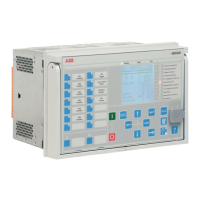10.3.4.1 Phase mode setting
PHQVVR is designed for both single-phase and polyphase ac power systems, and
selection can be made with the
Phase mode
setting, which can be set either to the
"Single Phase" or "Three Phase" mode. The default setting is "Single Phase".
The basic difference between these alternatives depends on how many phases are
needed to have the voltage variation activated. When the
Phase mode
setting is
"Single Phase", the activation is straightforward. There is no dependence between
the phases for variation start. The START output and the corresponding phase
start are activated when the limit is exceeded or undershot. The corresponding
phase start deactivation takes place when the limit (includes small hysteresis) is
undershot or exceeded. The START output is deactivated when there are no more
active phases.
However, when
Phase mode
is "Three Phase", all the monitored phase signal
magnitudes, defined with
Phase supervision
, have to fall below or rise above the
limit setting to activate the START output and the corresponding phase output,
that is, all the monitored phases have to be activated. Accordingly, the deactivation
occurs when the activation requirement is not fulfilled, that is, one or more
monitored phase signal magnitudes return beyond their limits. Phases do not need
to be activated by the same variation type to activate the START output. Another
consequence is that if only one or two phases are monitored, it is sufficient that
these monitored phases activate the START output.
10.3.4.2 Variation detection
The module compares the measured voltage against the limit settings. If there is
a permanent undervoltage or overvoltage, the
Reference voltage
setting can be set
to this voltage level to avoid the undesired voltage dip or swell indications. This is
accomplished by converting the variation limits with the
Reference voltage
setting
in the variation detection module, that is, when there is a voltage different from the
nominal voltage, the
Reference voltage
setting is set to this voltage.
The
Variation enable
setting is used for enabling or disabling the variation types.
By default, the setting value is "Swell+dip+Int" and all the alternative variation types
are indicated. For example, for setting "Swell+dip", the interruption detection is not
active and only swell or dip events are indicated.
In a case where
Phase mode
is "Single Phase" and the dip functionality is available,
the output DIPST is activated when the measured TRMS value drops below the
Voltage dip set 3
setting in one phase and also remains above the
Voltage Int set
setting. If the voltage drops below the
Voltage Int set
setting, the output INTST
is activated. INTST is deactivated when the voltage value rises above the setting
Voltage Int set
. When the same measured TRMS magnitude rises above the setting
Voltage swell set 3
, the SWELLST output is activated.
There are three setting value limits for dip (
Voltage dip set 1..3
) and swell activation
(
Voltage swell set 1..3
) and one setting value limit for interruption.
If
Phase mode
is "Three Phase", the DIPST and INTST outputs are
activated when the voltage levels of all monitored phases, defined with
the parameter
Phase supervision
, drop below the
Voltage Int set
setting
value. An example for the detection principle of voltage interruption for
"Three Phase" when
Phase supervision
is "Ph A + B + C", and also the
corresponding start signals when
Phase mode
is "Single Phase", are as
shown in the example for the detection of a three-phase interruption.
1MRS757644 H Power quality measurement functions
620 series
Technical Manual
1091

